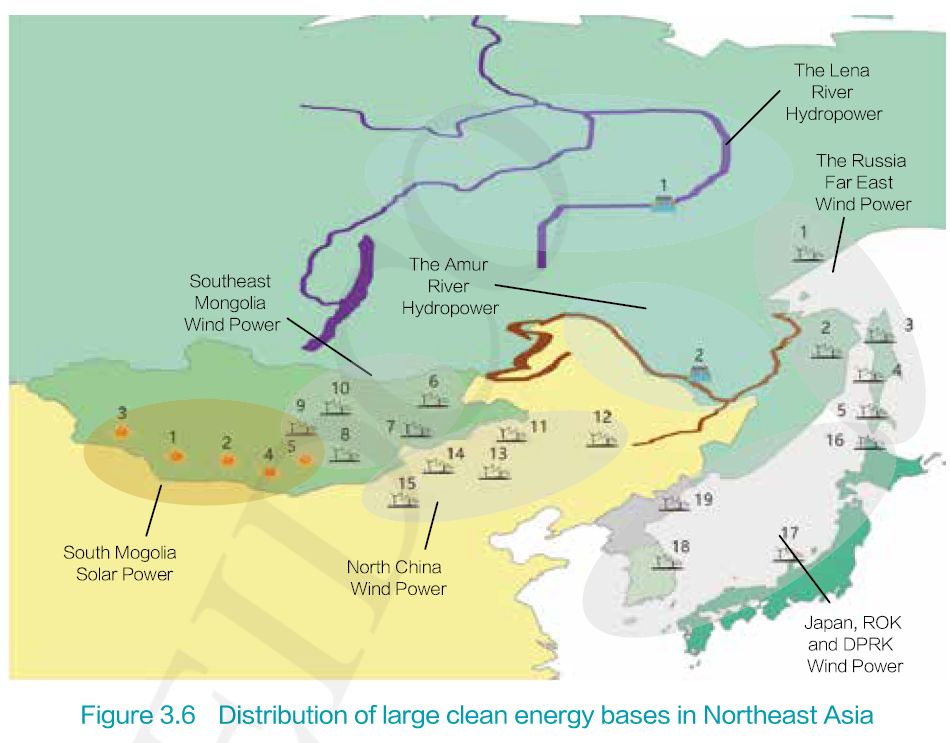
Lena is one the 10 greatest rivers of the world, and its basin is the least affected by hydropower dams and other water infrastructure. So far only one major tributary – the Viluy river has two dams (one of those unfinished due to lack of demand for energy).
During several decades harnessing hydropower potential of Lena basin was proposed many times by Russian and Chinese engineers and investors. The map above has been produced by Global energy Interconnection Development Cooperation Organization (GEIDCO – a global lobbyist initiated by the China State Grid Co.) which has already published a preliminary plan for the North-east Asia Energy Interconnection, in which this pristine river basin is to become an “energy base” to produce 40 GW of hydropower for consumers in Japan and Korea. The GEIDCO published similar plans for “harnessing” the Amur, Congo and other major river systems of the world in the name of “clean energy” and is actively cooperating with many UN agencies to promote this “bright vision of the future”.
Among 5 giant hydropower stations planned recently in Lena River basin the 1200 MW Mokskaya Hydro on Vitim River has particularly rich history of planning, lobbying and abandonment. Rich mythology of the energy sector describes this power plant as essential for every developmental need of Asian Russia.
An article by prominent expert on regional energy system Dr. Gennady Borisov praises the inevitable sacrifice of Vitim River to hydropower from every possible angle: “ The emergence of a new generation source on the border of the Republic of Buryatia and the Zabaikalsky Province will meet the long-term energy needs of the Baikal-Amur Railroad and adjacent territories. The total power of prospective consumers of this zone exceeds 1000 MW (mostly mining industry). The construction of the Vitim hydropower complex will also create an energy bridge between the united energy system of the Far East and the UES of Russia, ensure the energy security of the north part of the Baikal region, reduce electricity tariffs in the Republic of Buryatia and Zabaikalsky Province, increase the possibility of more efficient regulation of the Lake Baikal level and address the issue of electricity supply to Mongolia. The construction of a hydroelectric power plant will allow the introduction of irrigated agricultural land in the Muya lowland, called the “oasis of Eastern Siberia”. The creation in the future of the Vitim cascade of HPPs will allow Russia to become the largest logistics operator, which will affect the supply of electricity to the Asian market. Unlike hydroelectric power plants located in densely populated areas, the advantage of the Mokskaya HPP is the lack of settlements, arable lands and cultural pastures at the site of the future reservoir…”
That is why at least three times the mighty Vitim was sentenced to damming, but three times the sentence was reversed. In the last episode, in June 2020 Kommersant daily mentioned a proposal of the Ministry of Energy to build a power plant to supply electricity to of the second stage of development of the “Eastern Polygon” of Russian Railways (a zone combining Baikal-Amur and Trans Siberian railroads). Russian Government hastily upgrades Siberian railroads in a belated attempt to stay relevant to the transportation routes of the Chinese Belt and Road Initiative. The Ministry proposed to revive the Soviet project of the Mokskaya Hydro in the north of Buryatia to provide electricity to consumers of the Bodaybo power district of the Irkutsk region. Minister Novak hinted that he is looking at other options as well , but Mokskaya is the preferred option due to multiple benefits it allegedly brings to the region. The announcement came 2 days after the same Ministry got the Government’s approval for an “Energy Strategy of Russia till 2035” which clearly did not envision construction of a single new hydrodam…
At that time the RwB was preparing for publication a long analytical paper “Hydropower in Russia. The Epilogue.” After hearing the news we changed the final punctuation: ”…The Epilogue?” and added a couple of paragraphs on Mokskaya Hydro describing why that project is likely a mirage. We did not conduct any further attempts to confront emerging hydropower doom – in our experience the same Minister Novak once evaluated “flood control hydropower” proposal in Amur River basin and on his own arrived at a fair conclusion that the whole scheme is uneconomical and useless scam. From the same episode we knew that people at the Ministry often read what we publish. So we decided to give the Ministry a chance to evaluate power supply options without “active external interference” from NGOs.
As we learned today the Ministry of Energy has dropped the Mokskaya Hydro as a power supply option for the Baikal-Amur Railroad and related industry. No official conclusion is available, but the press says that the two main reasons were “high costs” and “long construction period” (as if in June this was not obvious). We could add several more reasons, but if these two are sufficient, we are quite happy.
We are much less happy with the mind boggling list of “options still considered by the Ministry”, which include 1.7 GW of thermal power plants on gas and coal as well as 450 MW Telmamskaya Hydro planned on already dammed Mamakan River by En+Group. It looks that getting money fast from the state budget is the main driver behind this “planning”. Otherwise the planners would inevitably remember that on adjacent Viluy River Svetlinskaya Hydro still has a slot ready for a 85 MW turbine, which was left empty due to lack of demand 20-30 years ago…
The Mokskaya Hydro was the last active large hydropower dream of the Russian Government. Hopefully we may replace the question mark with a full stop again: “Hydropower in Russia. The Epitaph.”

